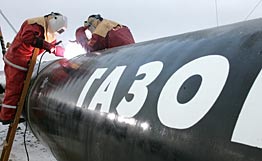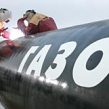
Gazprom Seeks Far Eastern Gas Riches
Publication: Eurasia Daily Monitor Volume: 6 Issue: 172
By:

The state-run natural gas monopoly Gazprom has moved to control natural gas resources in Russia’s vast eastern regions by taking over new gas deposits and building new gas pipelines. In late August, Gazprom argued that the Chayadinskoye deposit lacked sufficient reserves to fill the Yakutiya-Vladivostok pipeline and asked the government to grant four deposits (Srednetyungskoye, Sobolokh-Nedzhelinskoye, Tas-Yuryakhskoye and Verkhnevilyuchanskoye) with combined reserves totaling 500 billion cubic meters (bcm). The gas giant also sought tax breaks in the Russian Far East, including zero gas export duty that would total $4.5 billion annually (Kommersant, August 25).
Gazprom’s ambitious plans to develop a new system of gas-producing centers and pipelines in the region include a gas pipeline to be built from the Chayadinskoye field in Yakutia to Khabarovsk. Gazprom expects to start production at the Chayadinskoye deposit in 2016, and to eventually raise gas output there up to 30 bcm per year.
In recent years, Gazprom has repeatedly pledged to take over the largest gas fields in Eastern Siberia and the Russian Far East. Hence, it has tried to expand its presence in all four future gas production centers: Sakhalin, Yakutia, Krasnoyarsk and Irkutsk regions. The Russian media noted that Gazprom was keen to monopolize nearly all natural gas resources in the Russian Far East. Pursuing its bid to control Sakhalin-3, Gazprom appeared to ignore Putin’s invitation to Shell to join the project, Nezavisimaya Gazeta suggested on August 25. On August 22, Gazprom’s Deputy CEO Alexander Ananenkov met Medvedev’s envoy in the region, Viktor Ishayev, and sought his support, arguing that the Sakhalin-3 gas was needed in order to supply domestic consumers via the Sakhalin-Khabarovsk-Vladivostok pipeline, the daily wrote (Nezavisimaya Gazeta, August 25).
In July, Ananenkov announced that Gazprom secured licenses to develop the West Kamchatka offshore gas deposits on July 7 and the Sakhalin-3 license on July 22. He also pledged to cooperate with the state-run oil giant Rosneft to develop the West Kamchatka Koryakiya-1 and Koryakiya-2 gas deposits (Interfax, July 31). In January 2004, the Russian government annulled the results of the Sakhalin-3 tender, which was won by a consortium led by ExxonMobil in 1993. Gazprom has long lobbied to join the Sakhalin-3 project and argued that gas production could start by 2013-2014.
To highlight the importance of Gazprom’s Far Eastern expansion, known as its "Eastern Program," the inauguration of its latest project was attended by the country’s top officials. Prime Minister Vladimir Putin announced in Khabarovsk region on July 31 that the Sakhalin-Khabarovsk-Vladivostok pipeline launch marked the creation of a new gas industry hub in the Russian Far East. Russia’s Far Eastern and East Siberian regions are expected to produce up to 150 bcm per year by 2020, he said.
Putin said that the new deposits are due to supply fuel and feedstock for major domestic energy and gas processing projects. The Sakhalin-Khabarovsk-Vladivostok 1,800-kilometer pipeline will also target export markets in Asia-Pacific eventually, he explained, while expressing his confidence that the first stage of the pipeline project would be completed by 2011 (Interfax, ITAR-TASS, RIA-Novosti, July 31). Ananenkov told Putin that Gazprom aimed to raise the pipeline’s capacity from 7 bcm per year to 28 bcm per year at the next stage. Ananenkov also pledged to raise gas production up to 70 bcm per year in Sakhalin, 53 bcm in Yakutiya, 48 bcm in Irkutsk region and 35 bcm in Krasnoyarsk region by 2030 (Interfax, July 31).
The existing Sakhalin-Komsomolsk-on-Amur-Khabarovsk pipeline has limited capacity. When this pipeline was built in 1987 it had a capacity of 4.5 bcm per year, but it has never pumped more than 1.5 bcm per year. This pipeline was eventually extended to Khabarovsk, but its actual capacity did not exceed 2 bcm per year.
The new Sakhalin-Khabarovsk-Vladivostok gas pipeline was launched despite environmental concerns. Environmentalists warned that the project would adversely affect the environment, notably the Khasan natural reserve. They also argued that the pipeline’s planners ignored a potential earthquake risk in the area (Prima-Media, August 17). Gazprom has estimated local demand in Khabarovsk region at 3 bcm per year, 4.5-5 bcm in Sakhalin and 5 bcm in Primorie region. Nonetheless, it pledged to create a new system of gas pipelines, notably the Sakhalin-Khabarovsk-Vladivostok pipeline, to funnel gas from the Sakhalin offshore deposits with a capacity significantly exceeding local demand. Therefore, despite its official promises to prioritize domestic customers, Gazprom’s Eastern Program was aimed at offering Russian natural gas to East Asian importers at international prices. Gas from Yakutiya could also be used for exports to Asia-Pacific countries, Ananenkov announced in July. He also pledged to start construction of Yakutiya-Vladivostok gas pipeline in 2012 as part of Gazprom’s Eastern program (Interfax, July 31).
Meanwhile, Gazprom also conceded that its project to build a gas pipeline to China remained stalled (Rossiya, August 13). In early August, Ananenkov said that supplies via the Altai pipeline would not start in 2011 as planned earlier. Three years ago Putin also promised to export up to 40 bcm of Russian gas to China via a 6,700-kilometer $10 billion Altai pipeline. Moreover, in March 2006, Gazprom and the China National Petroleum Corporation (CNPC) signed a memorandum on the delivery of Russian natural gas to China from 2011, which was a follow-up to the partnership deal signed in October 2004.
However, the Altai pipeline project became even less feasible after CNPC agreed to import 2.25m tons of LNG annually from Australia’s Gorgon LNG project. The $41 billion LNG deal highlighted Gazprom’s limited clout as a natural gas supplier in the Asia-Pacific. Simultaneously, the economic viability of the Yakutiya-Vladivostok and the Sakhalin-Khabarovsk-Vladivostok pipelines as major export routes also now appears to be questionable.




